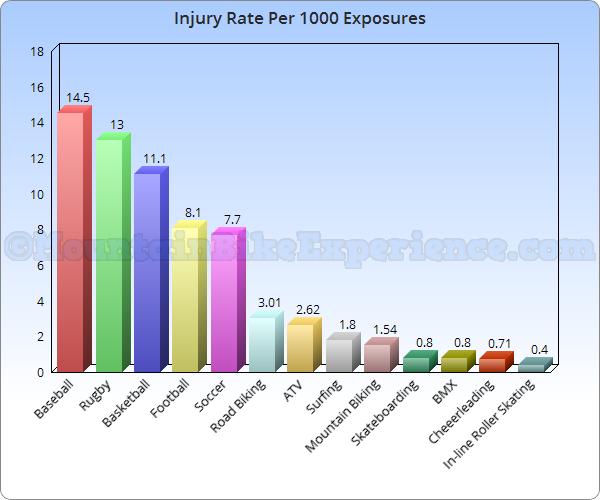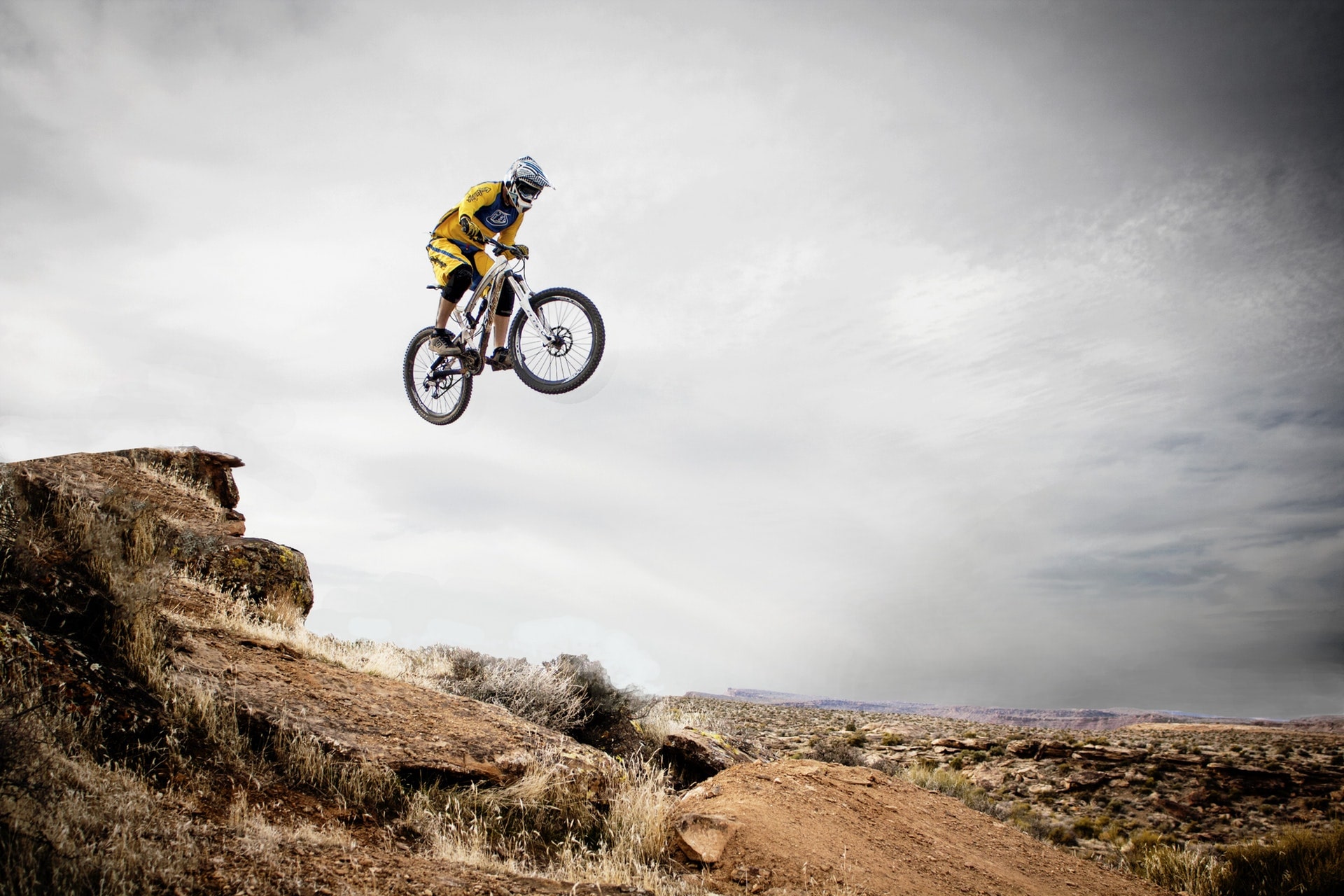Mountain biking is generally considered a dangerous and extreme sport by the average person. I decided to look into it to see just how common the injuries are compared to other sports and the results might surprise you.
The short answer is that mountain biking is less dangerous than most other sports. Mountain biking as more injuries than sports such as roller skating, but far less than sports such as football and baseball.
How Dangerous Is Mountain Biking Compared To Other Sports?
Before I started writing this article, I would not have guessed what the actual statistics and reported injury rates show.
How dangerous is mountain biking? Is it a dangerous sport?
Let’s jump right into it with a graph or the reported injury rates per 1000 exposures for many sports. When it says rate per 1000 exposures, it means per event or per hour. Per hour is more common for measurements.

I did not include Bull Riding and Ice Hockey in this graph. Bull Riding, which is inherently dangerous, has a rate of 119 and Ice Hockey has a rate of 32.2. If I included them in the above graph, everything else would be such a small blip it would be hard to compare mountain biking to other common sports.
The graph show the frequency of reported injuries, but not the seriousness of the actual injuries.
However, the rate can not be ignored. A person is nearly 10x more likely to get hurt playing basketball than mountain biking. Quite often the mountain biking injury will be a little more severe with shoulder damage or a concussion vs perhaps a broken finger. Rugby, however, is both high in frequency and the actual injuries are not exactly trivial.
So mountain biking has a lower rate of incidence compared to many other common sports. In that aspect, mountain biking is not as dangerous as most other common sports. As a sport mountain biking has a far lower rate of incidents than I would have expected. Just remember to take precautions and wear safety equipment, especially a good helmet.
Note that these numbers for mountain biking at 1.54 incidents per 1000 hours include both day and biking at night. Mountain biking at night has other dangers beyond the normal ones you see in the day but with less daylight in the winter months night biking is common.
The Potential Risks
It’s important to differentiate between the different types of cycling which are usually lumped together into a statistic. In the graph, you’ll note that road biking has almost twice the injury rate of mountain biking. This is mainly because on the road there are cars. When a car hits a person on a bike, the injuries are usually serious head injuries.
Cross country mountain biking falls in between downhill mountain biking and road biking because with cross country biking riders take mild off-road trails as well as lesser-traveled roads like fireroads and dirt car trails.
Here we are talking about mountain biking where 70% of injuries are caused by human error.
The most common mountain biking injuries are:
- Fractured forearm
- Fractured hand or wrist
- Fractured shoulder or clavicle
- Head trauma or concussion
- Trauma to the face
That sounds like a lot but let’s look at what are the common injuries. The first 3 are the most common. The most common scenario is hitting something with the front tire and the bike not going over it but you going over the handlebars. Many times it’s things as not quite making it over a fallen log.
When riders go over the handlebars, most times they put their hands out to stop themselves and on hitting the ground break a forearm, hand, or shoulder bone. A head injury can happen too as the last step of stopping on the ground.
For this reason, having a top-notch helmet is extremely important to say the least. A quality helmet can reduce head injuries by 39% and facial trauma by 28%. So make sure to get the best helmet you can.
Chances of Serious Injury
While we now know the injury rate of total injuries, the type of injury can make a big difference. So what are the common accidents?
The most common injury type are fractures. In a recent WEM/Whistler study, 27.6% of the breaks were shoulder or clavicle breaks, 24.7% were wrist fractures, 11.1% were hand and finger fractures, and 5.2% were serious spine and neck breaks. 22.9% on the injuries were concussions or brain injury. Only 1.8% of people had to be brought in for medical care on a stretcher.
So only 5% of the injuries were life-threatening spine and neck breaks. While breaking a bone is serious, it does heal given a little time. This 5% stat is the one I’m most interested in.
To a lesser extent, abrasions are fairly common, especially on the lower legs. for most of these, riders did not seek out medical care.
So what are the causes of these injuries? According to studies by studies, 72% of the time they were riding errors with 31% of time bad trail conditions were the cause. I know…the study adds up to 103%.
What this means is that if you get the proper safety equipment and learn good riding techniques, you can make a big difference in avoiding injuries.
What Risks Are Controlled and How To Avoid Them
There are risks of injury that the rider can control (the 72% above), and ones that the rider is at the mercy of mother nature.
So let’s look at what the average mountain bike rider can do to avoid danger and make for a safe ride on your mountain bike.
Get in Shape
Riding takes a serious toll on the body. Every rock and bump puts stress on the body. Like many sports, getting into peak physical condition is a great way to deal with the rigors of mountain biking.
Stretch Before Riding
Just like exercise, becoming more flexible will help you endure the physical strain from mountain biking. Many gyms have classes such as cardio and yoga classes that can help with flexibility and endurance.
Plan Your Route
Make sure to plan ahead for your daily ride. You should know what obstacles and terrain to expect, what dangerous such as cliffs to watch out for, and roughly how long of a ride it will be. It also helps to know the rules of the mountain bike trails that most bikers go by so that you’re all on the same page and less likely to run into each other.
Maintain Your Equipment
If you bike has a problem, then as the rider you’ll have a problem too. Maintaining your brakes are functioning and adjusted, your tires are properly inflated and no major tire damage. Check your frame for cracks, and check all of your bolts to be sure everything that is meant to stay on your bike does.
Not having your brakes working when you expect them to can cause a really bad day, so just check over your bike before riding to start things off on the right foot.
Wear Proper Safety Equipment
Wearing a bike helmet makes you 39% less likely to have a brain injury. That makes wearing a high-quality helmet a necessity.
But don’t forget all of that other equipment that helps you to have a safe and enjoyable ride.
You’ll want to wear mountain biking gloves to protect from bloody knuckles, good quality shoes, and of course biking pads and armor. You’ll want elbow pads, knee pads, and shin guards to mitigate danger as much as possible. If you’re just starting out, make sure you have everything you need to get going and have a safe ride.
Adjust Your Bike For Your Style
Your bike needs to be setup to match your riding style. Things like your brake levers need to get adjusted so that your grip on the handlebars isn’t compromised for instance. This is key to avoid repetitive injuries such as Tennis Elbow.
Bring Water On Your Ride
Sometimes this one isn’t as obvious, but staying hydrated is absolutely necessary even in cooler conditions. When you get dehydrated, everything takes a toll on your body and if you’re not at peak focus you can make mistakes due to being tired. Remember that 72% of injuries come from rider error.
So make sure you include water bottles in your biking kit so you’re prepared for as much as possible.
Learn Riding Techniques from Experts
There are tons of courses taught by experts. Taking one will teach you the proper techniques so that you are less likely to make rookie mistakes.
Don’t Be Stupid
Quite often beginners can get a little too much confidence and take on more than they can handle. Build your way up through tougher obstacles slowly so that you don’t find out the hard way.
This falls in a little bit with knowing your route, but don’t run downhill at full blast blindly and literally leaping before you look. There’s a reason that saying exists, and it’s because it’s easy to assume what is on the other side, but if you’re airborn you don’t want a nasty surprise waiting for you on the ground, no matter how far it is.
Pay Attention
Don’t get distracted while you’re riding. You’ll want to look ahead for the next hundred feet but focus on the immediate 10 feet so that you don’t flip over obstacles.
The best way to do this is to pace yourself and take trails appropriate to your skill level. Mountain bike riding is an acquired skill and as you learn how to look and size up the situation, you’ll be able to do this step naturally.
Bail When You Have To
If all else fails and it’s necessary, bail.
It’s far easier to fix a bike than a person with a serious injury. There is no dishonor in knowing and taking decisive action when you can’t avoid a bad situation.
All of the above things can really help to increase mountain biking safety and mitigate mountain biking injuries when possible.
What Risks are Uncontrollable
Finally, let’s address that other 32% of injury causes: mother nature. Sometimes you can do everything right but things are just not in your favor.
It could be glare from the sun temporarily making it so you can’t see an obstacle correctly. The path could be wet and the tires slip on a wet rock.
There are a number of factors you have no control over and being prepared is your only way to mitigate risks.
All Sports Have Danger So Mitigate Risks the Best You Can
What this all comes down to is that mountain biking has some danger inherent to any sport. All you can do is mitigate the risks you can through proper planning and preparation and enjoy the sport if you can live with the reduced risk.
Mountain biking is thoroughly enjoyable and most active mountain bikers would say that the risk is worth it for the reward that they get.






